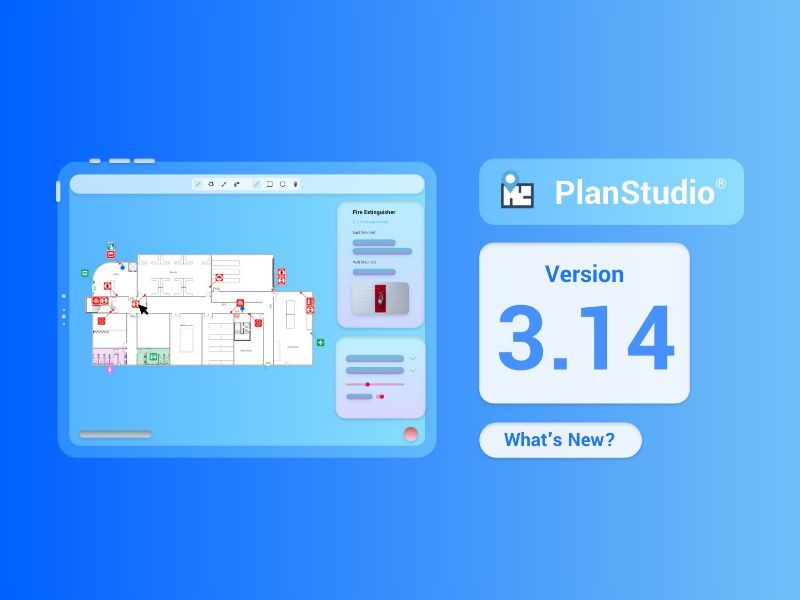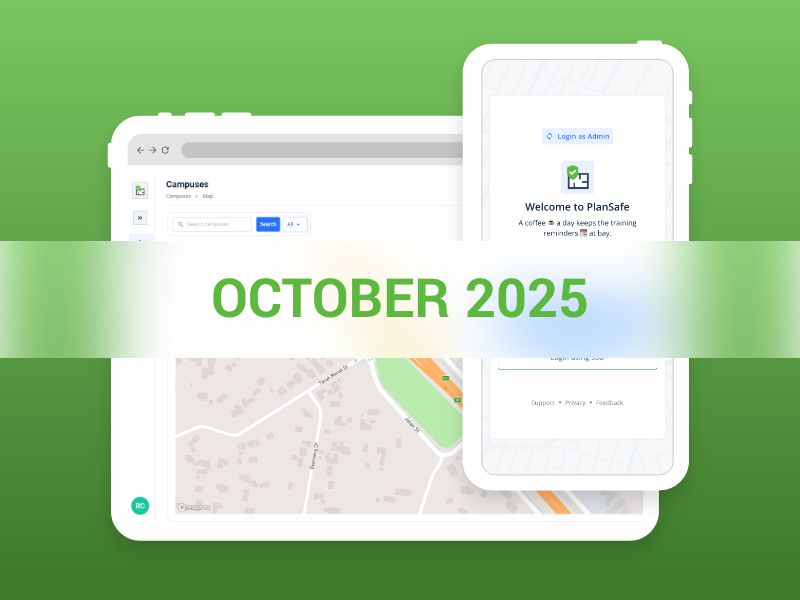Written by
Helen Hall
Published on
September 5, 2024
Over the past 5 years Locatrix has grown its partner network, onboarding over 100 fire safety specialist companies, becoming the technology partner the industry has long anticipated. Having embraced Locatrix’s online safety training application PlanSafe, these partners are now managing over 300 PlanSafe training portals for their customers and have mapped over 115,000,000 sqm of plans in PlanStudio.
PRM is a great example of a thriving partner with the enthusiasm to innovate to best support its customers in the Health and Aged Care sector.
We spoke with PRM’s Business Manager, Aaron Gormly who has been using PlanStudio and PlanSafe to create bespoke plans to carefully record building details to provide a better informed and practical emergency plan where building and operational complexities cannot be ignored.
A holistic approach to the identification, prevention, preparation, response and recovery of likely emergencies that could impact the workplace. Emergency plans are more than the folder on the shelf. Emergency Plans include the new staff members induction, a contractor’s induction, an annual Emergency Control Organisation (ECO) members training program, and skills maintenance activities for ECO members and general occupants. The overt parts of the site Emergency Plan we usually identify are simply known as the evacuation diagrams and the Emergency Procedures.
Organisations need a tailored emergency plan based on their risk profile and environment. If a fire engineer indicates that certain systems must interact with ECO members, this should be included. Workplaces with high-risk factors like non-ambulant occupants, hazardous materials, or flooding risks are good examples of workplaces requiring a customized plan.
Tactical Fire Plans form part of a plan known as an ‘Emergency Services Information Package’. If the workplace holds large quantities of hazardous chemicals, or has high fuel loading or highly combustible contents, if it could impact neighbouring facilities and infrastructure, is multi-level and possibly has fire engineered solutions within, a higher level of integration with responding fire services will see an emergency detected and suppressed much faster. In NSW, the ESIP and Tactical Fire Plan guidelines from FRNSW broadly stipulate that any facility with schedule 11 manifest quantities of hazardous materials, and or a fire control room should have this package created and submitted to FRNSW.
Critically, we need to create a plan that is functional and self-propelling. Key notes of focus need to be: How relevant is it? How easily accessible is it? Is it functional? and How its being maintained? It needs to work in the real world by real people, with their own sets of challenges.
Take a multi-story aged care or healthcare facility for example.
It’s common to find emergency plans that do not take adequately into account the challenges of evacuating non and semi-ambulant people through a fire floor. The plan may make reference to the use of fit for purpose evacuation apparatus, such as stair slides or sheets.
What we neglect to factor in here is that the building has been designed and maintained, to facilitate lateral evacuations to pre-identified safe spaces to enable the ongoing safety of evacuees, and continuity of care.
Further, we do not account for the abilities of staff members to perform a highly complex and dangerous manoeuvre in placing fragile people in concrete fire stairs.
PRM make assessments to determine the most appropriate and safe evacuation methods and locations based on:
a. The installed detection, suppression and air handling systems
b. Compartmentation- type and number
c. Communications methods between staff
d. Fuel loading and other special hazards such as imaging machines
e. Staff to patient ratios
f. Complexity of the care being given
g. Proximity of responding emergency services
Annually by the site Emergency Planning Committee, at set dates, usually at the anniversary date of the inception of the plan
The annual review date, or should an event occur which calls into question the validity of the emergency plan. This may include a change to business operations, a drill or exercise which tests the objectives of the plan, or an adverse event either at the facility or a like facility, which will evidence that the plan has gaps which need to be remedied. The Australian Standard AS 3745 calls for the EPC to then re-test the plan by virtue of some drill or exercise, to validate the new version of the emergency plan as being accurate and functional.
There can be immediate or long lasting adverse outcomes to life safety, the building they occupy and local environment. This arises from not having identified what is likely to occur, create safe work practices to prevent the occurrence of these likely events, have staff that can rapidly identify, contain and isolate a problem- then hand over to the responding combat agency with speed and efficiency.
There is the potential for brand and reputational damage with stakeholders losing confidence in the business and their ability to trade and perform their commercial functions.
There is of course the consequence of disruption to trade, which can lead to temporary suspension of business functions or permanent closure. This is where PRM work with clients to ensure that their workplace Emergency Plan tethers to their Business Continuity goals and plans.
AS 3745 says that the EPC (after being trained and if they have tertiary qualifications or industry experience) can perform this function. In reality, most organizations do not want to carry the liability of making these assessments and they are unlikely to be insured to perform such work. As such organisations like PRM only employ current serving professional emergency services officers who are highly trained in contemporary emergency practices. Further, PRM approximately 15 years ago became heavily involved in the healthcare, aged care and disability support sectors, and have gone on to provide advice to multiple organisations in this area based on our immersion into the day to day operations of these facilities.
Yes in both aged care and in disability support. I have personally had the experience of responding to building fires at facilities where I have also created the emergency plans and trained staff in rapid response. On two occasions I have seen this lead to life saving outcomes for the occupants, who in both occasions could not evacuate under their own steam. Importantly in both occasions, the staff members who performed the evacuations knew what methods to use, and where to stage the residents so they could be physically removed by the responding fire service. The staff members, although traumatized, felt they had performed as well as they could, save saveable lives, and this assisted them to mentally cope with the outcome of the fire.
In another circumstance, our bushfire preparedness plans created for several clients were used effectively during the bushfire season of 2020. The plan focuses heavily of preparedness and prevention, promoting rapid advanced evacuation to identified safe facilities, enabling continuity of care for people with complex health needs. The plans were enacted successfully, with staff members evacuating well in advance of developing fire fronts, providing great life safety outcomes for all. In this instance success was in prevention, not in response.
The building owner has responsibilities regarding the installed systems in a property, but may not manage the site emergency plan. This can be owing to the AS 3745, the WHS regs and SafeWork codes of practice referring to the need for an employer to ensure emergency plans are in place. With that said, we often see the landlord in multi-tenanted facilities taking ownership of this vital area.
The exception to this common occurrence is where emergency plans are a performance measure on the Annual Fire Safety Statement. With changes in NSW from Feb 25 onwards regarding AS 1851 and the adequate testing of emergency plans, we will see more building owners take an interest in what emergency plans are in place in their buildings.
To occupy the building or area and operate in accordance with the expectations of the emergency plans or fire engineers’ reports.
PRM does not take the easy ‘compliance for compliance sake’ approach to emergency planning.
We partner with our clients to better understand who they are and how their businesses operate. We aim to provide a holistic solution, so their emergency plans are functional and adaptable, their staff feel safe and empowered, and their businesses are secure from the threat of potential emergencies.
All of our team are professional emergency responders based in major centers. We respond daily to emergencies, and bring that realism, pragmatism and context to our client engagements. Finally, and proudly, we believe we have hand chosen the best and most engaging operators in the industry. They become an extension to the facility they frequent as we partner our team members with the organizations they serve.
We are incredibly proud of the knowledge and experience we have developed, particularly working with clients who care for those in hospitals, aged care and disability support. We have a strong network of industry experts in complementary areas, where we can live by our motto- ‘always defer to better knowledge’. Whether it be security and personal threat, paramedical or industrial safety through to the built environment and its fire systems and air handling. We can answer many questions, but have a strong network around us to assist in the development of emergency plans and training plans for our clients in every class of building anywhere in Australia.
Find out more about PRM on their website
To find out more about PlanSafe



.png)